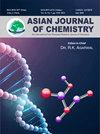Synthesis and Characterization of Biopotent Transition Metal Complexes of Schiff Base 2-{(1)-1-[2-(1,3-Benzothiazol-2-yl)hydrazinylidene]ethyl}-6,10b-dihydro-3H-benzo[f]chromen-3-one and their Biological Evaluation
Q4 Chemistry
引用次数: 0
Abstract
Three transition metal(II) complexes (M = Co/ Zn/Pd) were synthesized by using a newly synthesized Schiff base ligand 2-{(1E)-1-[2-(1,3-benzothiazol-2-yl)hydrazinylidene]ethyl}-6,10b-dihydro-3H-benzo[f]chromen-3-one (L) by conventional method. The structure of the compounds were determined by physical and analytical techniques like UV-visible, FT-IR, 1H and 13C NMR and mass spectroscopic techniques and the crystallinity and inter-planar distance of the complexes were confirmed by XRD. The electron density in HOMO and LUMO was determined by DFT studies. The studies of electronic spectra and measurements of magnetic susceptibility suggest that Co(II) complex shows an octahedral geometry, Pd(II) complexes show square planar geometry and (ZnL2Cl2) complex shows tetrahedral geometry. The molar conductivity results suggested the non-electrolytic nature of the metal(II) complexes. The synthesized compounds was tested against antibacterial activity for Gram-positive and Gram-negative bacteria. The molecular docking study demonstrated that the ligand and its metal(II) complexes possess antibacterial and anticancer properties, and the results showed that the compounds were effective against the microorganisms that were examined. Furthermore, the results found that metal(II) complexes provided enhanced immunity against cancer cell lines.希夫碱 2-{(1)-1-[2-(1,3-苯并噻唑-2-基)亚肼]乙基}-6,10b-二氢-3H-苯并[f]色烯-3-酮的生物活性过渡金属配合物的合成与表征及其生物学评价
利用新合成的希夫碱配体 2-{(1E)-1-[2-(1,3-苯并噻唑-2-基)肼亚基]乙基}-6,10b-二氢-3H-苯并[f]色烯-3-酮(L),通过传统方法合成了三种过渡金属(II)配合物(M = Co/ Zn/Pd)。通过紫外可见光、傅立叶变换红外光谱、1H 和 13C NMR 以及质谱等物理和分析技术确定了化合物的结构,并通过 XRD 证实了复合物的结晶度和平面间距。通过 DFT 研究确定了 HOMO 和 LUMO 的电子密度。电子能谱研究和磁感应强度测量结果表明,钴(II)配合物呈八面体几何形状,钯(II)配合物呈方形几何形状,而(ZnL2Cl2)配合物呈四面体几何形状。摩尔电导率结果表明,金属(II)配合物具有非电解性质。合成的化合物对革兰氏阳性菌和革兰氏阴性菌进行了抗菌活性测试。分子对接研究表明,配体及其金属(II)配合物具有抗菌和抗癌特性。此外,研究结果还发现,金属(II)配合物增强了对癌细胞株的免疫力。
本文章由计算机程序翻译,如有差异,请以英文原文为准。
求助全文
约1分钟内获得全文
求助全文
来源期刊

Asian Journal of Chemistry
化学-化学综合
CiteScore
0.80
自引率
0.00%
发文量
229
审稿时长
4 months
期刊介绍:
Information not localized
 求助内容:
求助内容: 应助结果提醒方式:
应助结果提醒方式:


